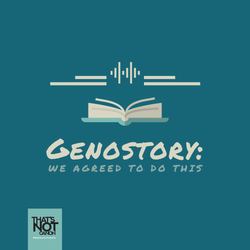Latest episode
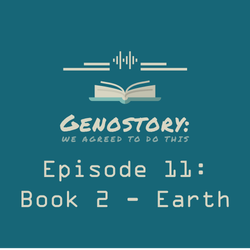
11. Ep. 1.11 Book 2: Earth
01:23:59||Season 1, Ep. 11Join historian John Lestrange for Episode 10 of Genostory: We Agreed to Do This, this month we'll be talking about season 2 of the show Avatat the Last Airbender and the depictions of genocide that can be found in it.Also, as a reminder to everyone listening Black Lives Matter and All Cops are Bastards.Special thanks to the app Hatchful and MJ Bradley for designing and editing out logo.Show music is "Crusade - Heavy Industry by Kevin MacLeod (incompetech.com) Licensed under Creative Commons: By Attribution 4.0 License.Sources:The Avatar wikihttps://avatar.fandom.com/wiki/Avatar:_The_Last_AirbenderThe Avatar IMDB Pagehttps://www.imdb.com/title/tt0417299/
More episodes
View all episodes
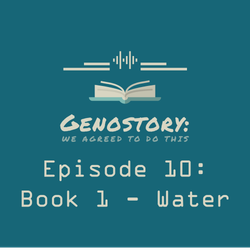
10. Episode 1.10:Book 1 - Water
56:04||Season 1, Ep. 10Join historian John Lestrange for Episode 10 of Genostory: We Agreed to Do This, this month we'll be talking about season 1 of the show Avatat the Last Airbender and the depictions of genocide that can be found in it.Also, as a reminder to everyone listening Black Lives Matter and All Cops are Bastards.Special thanks to the app Hatchful and MJ Bradley for designing and editing out logo.Show music is "Crusade - Heavy Industry by Kevin MacLeod (incompetech.com) Licensed under Creative Commons: By Attribution 4.0 License.Sources:The Avatar wikihttps://avatar.fandom.com/wiki/Avatar:_The_Last_AirbenderThe Avatar IMDB Pagehttps://www.imdb.com/title/tt0417299/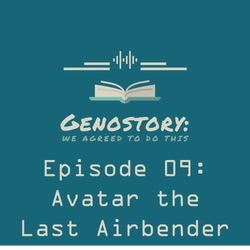
9. Episode 1.09: Avatar the Last Airbender
37:48||Season 1, Ep. 9Join historian John Lestrange and podcaster extraordinaire Frankie Bradley for Episode 9p of Genostory: We Agreed to do This. This month we'll be starting a new arc on the representation of genocide in cartoons by diving into Avatar the Last Airbender.Also, as a reminder to everyone listening Black Lives Matter and All Cops are Bastards.Special thanks to the app Hatchful and MJ Bradley for designing and editing out logo.Show music is "Crusade - Heavy Industry by Kevin MacLeod (incompetech.com) Licensed under Creative Commons: By Attribution 4.0 License.Sources:The Avatar wikihttps://avatar.fandom.com/wiki/Avatar:_The_Last_AirbenderThe Avatar IMDB Pagehttps://www.imdb.com/title/tt0417299/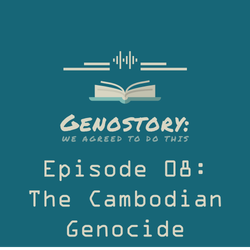
8. Episode 1.08: The Cambodian Genocide
32:28||Season 1, Ep. 8Join historian John Lestrange for Episode 8 of Genostory: We Agreed to do This. This month we'll be discussing a genocide that, too often gets overlooked, the Cambodian Genocide..Also, as a reminder to everyone listening Black Lives Matter and All Cops are Bastards.Special thanks to the app Hatchful and MJ Bradley for designing and editing out logo.Show music is "Crusade - Heavy Industry by Kevin MacLeod (incompetech.com) Licensed under Creative Commons: By Attribution 4.0 License.Sources:Heuveline, Patrick (2001). "The Demographic Analysis of Mortality Crises: The Case of Cambodia, 1970–1979". Forced Migration and Mortality. National Academies Press. pp. 102–105.Kiernan, Ben (2003). "The Demography of Genocide in Southeast Asia: The Death Tolls in Cambodia, 1975–79, and East Timor, 1975–80". Critical Asian Studies. 35 (4): 585–597.Locard, Henri (March 2005). "State Violence in Democratic Kampuchea (1975–1979) and Retribution (1979–2004)". European Review of History. 12 (1): 121–143Kiernan, Ben (October 2008). The Pol Pot Regime: Race, Power, and Genocide in Cambodia Under the Khmer Rouge, 1975-79. Yale University Press.Landsiedel, Peter, "The Killing Fields: Genocide in Cambodia", ‘’P&E World Tour’’, 27 March 2017.Mosyakov, Dmitry. "The Khmer Rouge and the Vietnamese Communists: A History of Their Relations as Told in the Soviet Archives". In Cook, Susan E., ed. (2004). "Genocide in Cambodia and Rwanda". Yale Genocide Studies Program Monograph Series. 1: 54.Valentino, Benjamin (2005). Final Solutions: Mass Killing and Genocide in the 20th Century. Cornell University Press. p. 84.William Branigin, Architect of Genocide Was Unrepentant to the End The Washington Post, 17 April 1998Gellately, Robert; Kiernan, Ben (2003). The Specter of Genocide: Mass Murder in Historical Perspective. Cambridge University Press.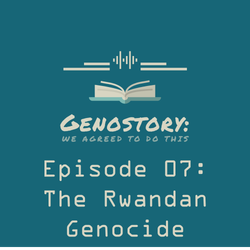
7. Ep. 1.07 The Rwandan Genocide
25:07||Season 1, Ep. 7Join historian John Lestrange for Episode 6 of Genostory: We Agreed to do This. This month we'll be discussing the most rapid and low tech of 20th century genocides, the Rwandan Genocide.Also, as a reminder to everyone listening Black Lives Matter and All Cops are BastardsSpecial thanks to the app Hatchful and MJ Bradley for designing and editing out logo.Show music is "Crusade - Heavy Industry by Kevin MacLeod (incompetech.com) Licensed under Creative Commons: By Attribution 4.0 License.Sources:Propaganda and Conflict: Evidence from the Rwandan Genocide by David Yanagizawa-Drott. The Quarterly Journal of Economics. August 2014Bystanders to Genocide: Why the US Let the Rwandan Tragedy Happen by Samantha Power. The Atlantic Monthly Sept 2001.Akhavan, Payam (1996). "The International Criminal Tribunal for Rwanda: The Politics and Pragmatics of Punishment". American Journal of International Law. 90 (3): 501–10.Aptel, Cicile (2008). "Closing the U.N. International Criminal Tribunal for Rwanda: Completion Strategy and Residual Issues". New England Journal of International and Comparative Law. 14 (2): 169–88.Dallaire, Roméo (2005). Shake Hands with the Devil: The Failure of Humanity in Rwanda. London: Arrow Books.Des Forges, Alison (1999). Leave None to Tell the Story: Genocide in Rwanda (Report). New York: Human Rights Watch.The Order of Genocide: The Dynamics of Genocide in Rwanda by Scott Straus Genocide Studies and Prevention: An International Journal. Vol 2. No 3. 2007.Totten, Samuel; Bartrop, Paul Robert; Jacobs, Steven L. (2008). Dictionary of Genocide, Volume 2: M–Z. Westport, CT: Greenwood Publishing Group.United Nations Department of Peacekeeping Operations (2008). "United Nations Peacekeeping Operations: Principles and Guidelines“Verwimp, Philip (2006). "Machetes and Firearms: The Organization of Massacres in Rwanda". Journal of Peace Research. 43 (1): 5–22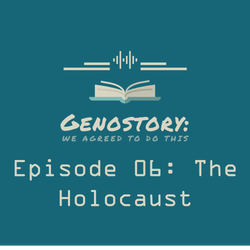
6. Ep. 1.06 The Holocaust
26:11||Season 1, Ep. 6Join historian John Lestrange for Episode 6 of Genostory: We Agreed to do This. This month we'll be discussing the most infamous of 20th century genocides, the Holocaust.Also, as a reminder to everyone listening Black Lives Matter and All Cops are BastardsSpecial thanks to the app Hatchful and MJ Bradley for designing and editing out logo.Show music is "Crusade - Heavy Industry by Kevin MacLeod (incompetech.com) Licensed under Creative Commons: By Attribution 4.0 License.Sources:The Treaty of Versailles https://www.loc.gov/law/help/us-treaties/bevans/m-ust000002-0043.pdf Steiner, John Michael (1976). Power Politics and Social Change in National Socialist Germany: A Process of Escalation into Mass Destruction. The Hague: Mouton. Kershaw, Ian (2008). Hitler: A Biography. New York: W. W. Norton & Company. Shirer, William L. (1960). The Rise and Fall of the Third Reich. New York: Simon & Schuster. Leonidas Hill (2001). "The Nazi Attack on 'Un-German' Literature, 1933-1945" IN: The Holocaust and the Book: Destruction and Preservation. Book Burning USHMM https://encyclopedia.ushmm.org/content/en/article/book-burning "Station 7: Courtyard and Bunker". Dachau Concentration Camp Memorial Site. http://www.kz-gedenkstaette-dachau.de/en/historical-site/virtual-tour/ History.com The Holocaust https://www.history.com/topics/world-war-ii/the-holocaust Goldhagen, Daniel (1996). Hitler's Willing Executioners: Ordinary Germans and the Holocaust. New York: Knopf. Longerich, Peter (2010). Holocaust: The Nazi Persecution and Murder of the Jews. Oxford; New York: Oxford University Press. Lifton, Robert J. (2000) [1986]. The Nazi Doctors: Medical Killing and the Psychology of Genocide (2000 ed.). New York: Basic Books. Auschwitz Memorial and Museum http://auschwitz.org/en/ Kubica, Helena (1998) [1994]. "The Crimes of Josef Mengele". In Gutman, Yisrael; Berenbaum, Michael (eds.). Anatomy of the Auschwitz Death Camp. Bloomington, Indiana: Indiana University Press. Holocaust Death Tolls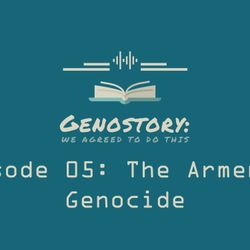
Ep. 1.05 The Armenian Genocide
35:21|Join historian John Lestrange for episode 5 of Genostory: We Agreed to Do This. In this episode John will go over the Armenian genocide and the historic contexts that allowed it to happen. Also, as a reminder to everyone listening Black Lives Matter and All Cops are Bastards Special thanks to the app Hatchful and MJ Bradley for designing and editing out logo. Show music is "Crusade - Heavy Industry by Kevin MacLeod (incompetech.com) Licensed under Creative Commons: By Attribution 4.0 License. Sources: Council of Europe Parliamentary Assembly Resolution 275. https://www.armenian-genocide.org/Affirmation.153/current_category.7/affirmation_detail.html Barsoumian, Hagop (1997), "The Eastern Question and the Tanzimat Era", in Hovannisian, Richard G (ed.), The Armenian People From Ancient to Modern Times, II: Foreign Dominion to Statehood: The Fifteenth Century to the Twentieth Century, New York: St. Martin’s, Dixon, Jeffrey S.; Sarkees, Meredith Reid (2015). A Guide to Intra-state Wars: An Examination of Civil, Regional, and Intercommunal Wars, 1816-2014. CQ Press. Akçam, Taner (2006). A Shameful Act: The Armenian Genocide and the Question of Turkish Responsibility. New York: Metropolitan Books. The Armenian Genocide: Context and Legacy by Doctor Rouben Adalian The Gardening States: Comparing State Repression of Ethnic Minorities in the Soviet Union and Turley, 1908 – 1945 by Duco Heija. Genocide Studies and Prevention: An International Journal. Vol 12. No 1. 2018 When Persecution Bleeds into Mass Murder: The Processive Nature of Genocide by Ugur U. Ungor. Genocide Studies and Prevention: An International Journal. Vol 1. No 2. 2006 Deportations and Massacres in the Cipher Telegrams of the Interior Ministry in the Prime Ministerial Archive (Basbakanlik Arsivi) by Taner Ackam. Genocide Studies and Prevention: An International Journal. Vol 1. No 3. 2006. Balakian, Peter (2003). The Burning Tigris: The Armenian Genocide and America's Response. New York: HarperCollins. "Exiled Armenians starve in the desert; Turks drive them like slaves, American committee hears ;- Treatment raises death rate". The New York Times. 8 August 1916. Dadrian, Vahakn (November 1991). "The Documentation of the World War I Armenian Massacres in the Proceedings of the Turkish Military Tribunal". International Journal of Middle East Studies. 23 (4): 549–76 (560). Charny, Israel W.; Tutu, Desmond; Wiesenthal, Simon (2000). Encyclopedia of genocide (Repr ed.). Oxford: ABC-Clio. p. 95 Kiernan, Ben (2007). Blood and Soil: A World History of Genocide and Extermination from Sparta to Darfur. Yale University Press. pp. 411 Vahakn N. Dadrian, The Role of Turkish Physicians in the World War I Genocide of Ottoman Armenians . The Holocaust and Genocide Studies 1, no. 2 (1986), pp. 177. Turkey's EU Minister, Judge Giovanni Bonello And the Armenian Genocide - ‘Claim about Malta Trials is nonsense’. The Malta Independent. "Erdogan: Turkey will 'never accept' genocide charges | DW | 04.06.2016". Deutsche Welle Akçam, Taner (4 September 2004). From Empire to Republic: Turkish Nationalism and the Armenian Genocide.
